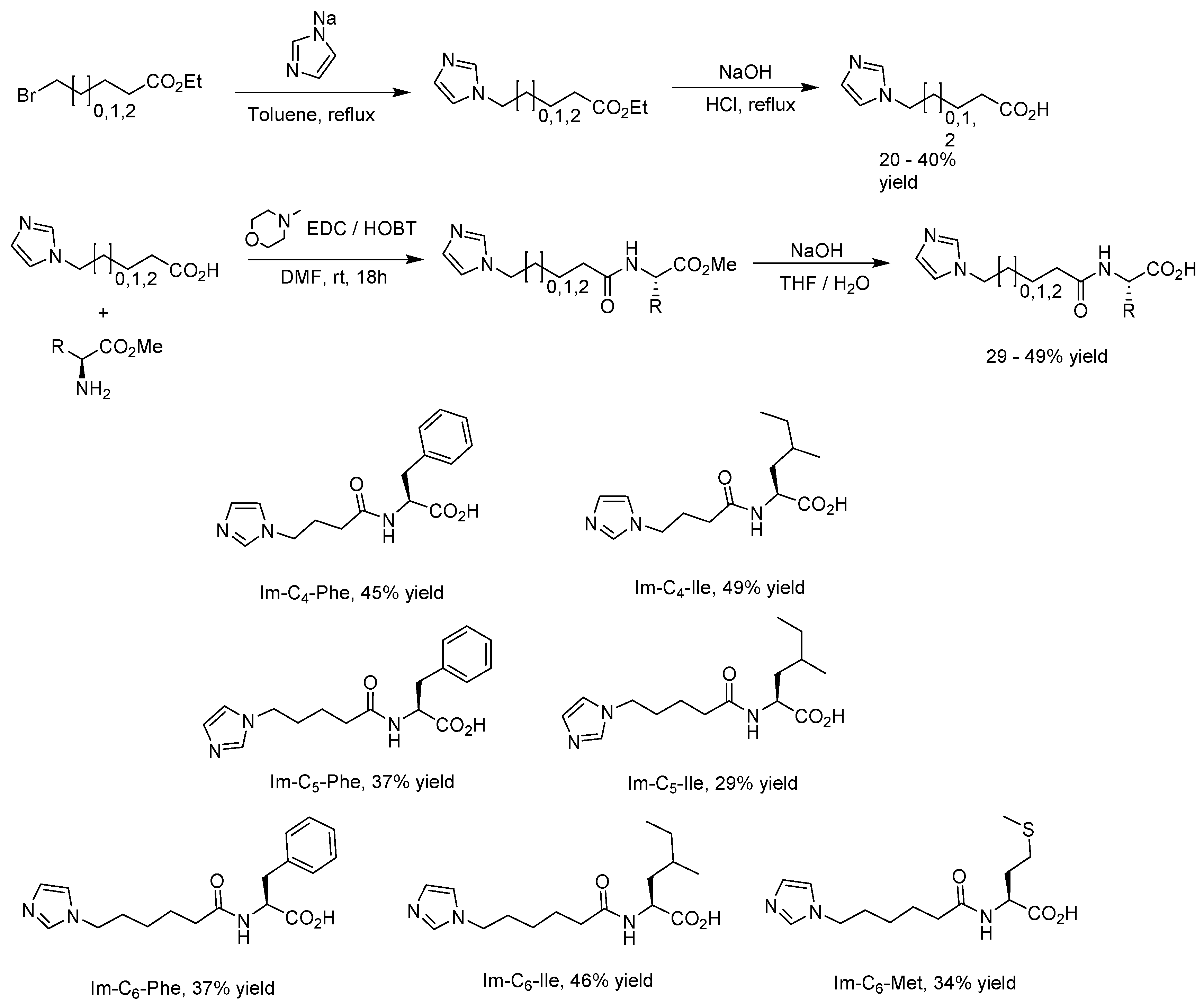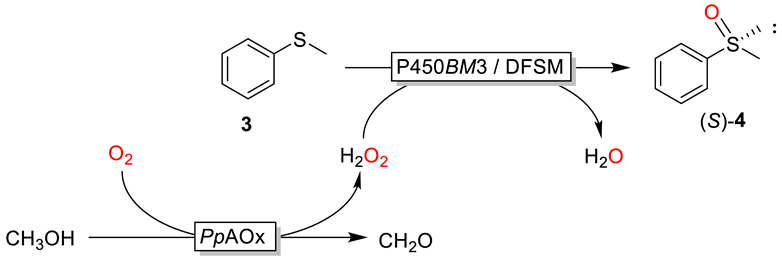P450BM3-Catalyzed Oxidations Employing Dual Functional Small Molecules
Abstract
1. Introduction
2. Results
2.1. Preparation of the Dual Functional Small Molecules (DFSMs)
2.2. Biocatalytic Transformations Using the DFSMs/P450BM3 System
3. Materials and Methods
3.1. Preparation of P450BM3 A74E/F87V/P386S
3.2. General Procedure for the Preparation of Im-C4-Phe and Im-C4-Ile
3.3. General Procedure for the Biocatalyzed Oxidation of Styrene and Thioanisole Employing the P450BM3/DFSM System
3.4. General Method for the Biocatalyzed Oxidations Employing the H2O2 In Situ Generation System
3.5. General Method for the Epoxidation of Styrene Using Precipitated P450BM3 F87A with DFSMs
4. Conclusions
Author Contributions
Funding
Acknowledgments
Conflicts of Interest
References
- Urlacher, V.B.; Girhard, M. Cytochrome p450 monooxygenases in biotechnology and synthetic biology. Trends Biotechnol. 2019. [Google Scholar] [CrossRef] [PubMed]
- Dong, J.; Fernández-Fueyo, E.; Hollmann, F.; Paul, C.; Pesic, M.; Schmidt, S.; Wang, Y.; Younes, S.; Zhang, W. Biocatalytic oxidation reactions—A chemist’s perspective. Angew. Chem. Int. Ed. 2018, 57, 9238–9261. [Google Scholar] [CrossRef] [PubMed]
- Wang, J.B.; Reetz, M.T. Biocatalysis chiral cascades. Nat. Chem. 2015, 7, 948–949. [Google Scholar] [CrossRef] [PubMed]
- Fasan, R. Tuning p450 enzymes as oxidation catalysts. ACS Catal. 2012, 2, 647–666. [Google Scholar] [CrossRef]
- Rudroff, F.; Mihovilovic, M.D.; Gröger, H.; Snajdrova, R.; Iding, H.; Bornscheuer, U.T. Opportunities and challenges for combining chemo- and biocatalysis. Nat. Catal. 2018, 1, 12–22. [Google Scholar] [CrossRef]
- Bornscheuer, U.T.; Huisman, G.W.; Kazlauskas, R.J.; Lutz, S.; Moore, J.C.; Robins, K. Engineering the third wave of biocatalysis. Nature 2012, 485, 185–194. [Google Scholar] [CrossRef] [PubMed]
- Schulz, S.; Girhard, M.; Urlacher, V.B. Biocatalysis: Key to selective oxidations. ChemCatChem 2012, 4, 1889–1895. [Google Scholar] [CrossRef]
- Hannemann, F.; Bichet, A.; Ewen, K.M.; Bernhardt, R. Cytochrome p450 systems—biological variations of electron transport chains. Biochim. Biophys. Acta-Gen. Subj. 2007, 1770, 330–344. [Google Scholar] [CrossRef]
- Strohle, F.W.; Kranen, E.; Schrader, J.; Maas, R.; Holtmann, D. A simplified process design for p450 driven hydroxylation based on surface displayed enzymes. Biotechnol. Bioeng. 2016, 113, 1225–1233. [Google Scholar] [CrossRef]
- Joo, H.; Lin, Z.L.; Arnold, F.H. Laboratory evolution of peroxide-mediated cytochrome p450 hydroxylation. Nature 1999, 399, 670–673. [Google Scholar] [CrossRef]
- Rude, M.A.; Baron, T.S.; Brubaker, S.; Alibhai, M.; Del Cardayre, S.B.; Schirmer, A. Terminal olefin (1-alkene) biosynthesis by a novel p450 fatty acid decarboxylase from jeotgalicoccus species. Appl. Environ. Microbiol. 2011, 77, 1718–1727. [Google Scholar] [CrossRef] [PubMed]
- Girhard, M.; Schuster, S.; Dietrich, M.; Dürre, P.; Urlacher, V.B. Cytochrome p450 monooxygenase from clostridium acetobutylicum: A new α-fatty acid hydroxylase. Biochem. Biophys. Res. Commun. 2007, 362, 114–119. [Google Scholar] [CrossRef] [PubMed]
- Matsunaga, I.; Ueda, A.; Sumimoto, T.; Ichihara, K.; Ayata, M.; Ogura, H. Site-directed mutagenesis of the putative distal helix of peroxygenase cytochrome p450. Arch. Biochem. Biophys. 2001, 394, 45–53. [Google Scholar] [CrossRef] [PubMed]
- Munro, A.W.; McLean, K.J.; Grant, J.L.; Makris, T.M. Structure and function of the cytochrome p450 peroxygenase enzymes. Biochem. Soc. Trans. 2018, 46, 183–196. [Google Scholar] [CrossRef] [PubMed]
- Hrycay, E.G.; Bandiera, S.M. The monooxygenase, peroxidase, and peroxygenase properties of cytochrome p450. Arch. Biochem. Biophys. 2012, 522, 71–89. [Google Scholar] [CrossRef] [PubMed]
- Xu, J.; Wang, C.; Cong, Z. Strategies for substrate-regulated p450 catalysis: From substrate engineering to co-catalysis. Chem. Eur. J. 2019, 25, 6853–6863. [Google Scholar] [CrossRef] [PubMed]
- Ma, N.; Chen, Z.; Chen, J.; Chen, J.; Wang, C.; Zhou, H.; Yao, L.; Shoji, O.; Watanabe, Y.; Cong, Z. The use of dual-functional small molecules in generating an efficient cytochrome p450bm3 peroxygenase. Angew. Chem. Int. Ed. 2018, 57, 7628–7633. [Google Scholar] [CrossRef]
- Li, F.-L.; Kong, X.-D.; Chen, Q.; Zheng, Y.-C.; Xu, Q.; Chen, F.-F.; Fan, L.-Q.; Lin, G.-Q.; Zhou, J.; Yu, H.-L.; et al. Regioselectivity engineering of epoxide hydrolase: Near-perfect enantioconvergence through a single site mutation. ACS Catal. 2018, 8, 8314–8317. [Google Scholar] [CrossRef]
- Chen, Z.; Chen, J.; Ma, N.; Zhou, H.; Cong, Z. Selective hydroxylation of naphthalene using the h2o2-dependent engineered p450bm3 driven by dual-functional small molecule. J. Porphyr. Phthalocyanines 2018, 22, 1–6. [Google Scholar] [CrossRef]
- Haines, D.C.; Chen, B.; Tomchick, D.R.; Bondlela, M.; Hegde, A.; Machius, M.; Peterson, J.A. Crystal structure of inhibitor-bound p450bm-3 reveals open conformation of substrate access channel. Biochemistry 2008, 47, 3662–3670. [Google Scholar] [CrossRef]
- Urlacher, V.B.; Makhsumkhanov, A.; Schmid, R.D. Biotransformation of beta-ionone by engineered cytochrome p450bm-3. Appl. Microbiol. Biotechnol. 2006, 70, 53–59. [Google Scholar] [CrossRef] [PubMed]
- Le-Huu, P.; Heidt, T.; Claasen, B.; Laschat, S.; Urlacher, V.B. Chemo-, regio-, and stereoselective oxidation of the monocyclic diterpenoid β-cembrenediol by p450 bm3. ACS Catal. 2015, 5, 1772–1780. [Google Scholar] [CrossRef]
- Whitehouse, C.J.C.; Bell, S.G.; Wong, L.-L. P450bm3 (cyp102a1): Connecting the dots. Chem. Soc. Rev. 2012, 41, 1218–1260. [Google Scholar] [CrossRef] [PubMed]
- Narhi, L.O.; Fulco, A.J. Characterization of a catalytically self-sufficient 119,000-dalton cytochrome p-450 monooxygenase induced by barbiturates in bacillus megaterium. J. Biol. Chem. 1986, 261, 7160–7169. [Google Scholar] [PubMed]
- Pereira, P.C.; Arends, I.; Sheldon, R.A. Optimizing the chloroperoxidase-glucose oxidase system: The effect of glucose oxidase on activity and enantioselectivity. Proc. Biochem. 2015, 50, 746–751. [Google Scholar] [CrossRef]
- Burek, B.O.O.; Bormann, S.; Hollmann, F.; Bloh, J.; Holtmann, D. Hydrogen peroxide driven biocatalysis. Green Chem. 2019, 21, 3232–3249. [Google Scholar] [CrossRef]
- Ni, Y.; Holtmann, D.; Hollmann, F. How green is biocatalysis? To calculate is to know. ChemCatChem 2014, 6, 930–943. [Google Scholar] [CrossRef]
Sample Availability: Samples of the compounds are not available. |





| Entry | DFSM | pH | c(2) (µM) | ee (%) b |
|---|---|---|---|---|
| F87A variant | ||||
| 1 | Im-C6-Phe | 8 | 117 | 72 |
| 2 | Im-C6-Ile | 8 | 94 | 59 |
| 3 | Im-C5-Ile | 8 | 58 | 54 |
| 4 | None c | 8 | 6 | 10 |
| 5 | Im-C6-Phe | 7 | 68 | 65 |
| 6 | Im-C6-Phe | 6 | ≤2 | -- |
| 7 | Im-C6-Phe d | 8 | 133 | 77 |
| V78A/F87A variant | ||||
| 8 | Im-C6-Phe | 8 | 54 | 6 |
| 9 | Im-C6-Ile | 8 | 97 | 22 |
| 10 | Im-C5-Ile | 8 | 80 | 19 |
| 11 | None | 8 | 11 | n.d. |
| 12 | Im-C6-Ile | 6 | ≤2 | n.d. |
| A74E/F87V/P386S variant | ||||
| 13 | Im-C6-Phe | 8 | ≤2 | n.d. |
| 14 | Im-C6-Ile | 8 | 17 | 4 (S) |
| 15 | Im-C5-Ile | 8 | 17 | 6 (S) |
| 16 | None | 8 | ≤2 | n.d. |

| Entry | DFSM | c(4) (µM) | ee (%) b |
|---|---|---|---|
| F87A variant | |||
| 1 | Im-C6-Phe | 232 | 40 |
| 2 | Im-C6-Ile | 178 | 38 |
| 3 | Im-C5-Ile | 151 | 35 |
| 4 | None | 78 | 6 |
| V78A/F87A variant | |||
| 5 | Im-C6-Phe | 103 | 41 |
| 6 | Im-C6-Ile | 75 | 40 |
| 7 | Im-C5-Ile | 77 | 44 |
| 8 | None | 53 | 4 |
| A74E/F87V/P386S variant | |||
| 9 | Im-C6-Phe | 129 | 47 |
| 10 | Im-C6-Ile | 98 | 51 |
| 11 | Im-C5-Ile | 108 | 53 |
| 12 | None | 65 | 8 |

| Entry | DFSM | c(4) (µM) | ee (%) b |
|---|---|---|---|
| 1 | Im-C6-Phe | 381 | 31 |
| 2 | Im-C6-Ile | 359 | 33 |
| 3 | Im-C5-Ile | 320 | 30 |
| 4 | None | 248 | ≤3 |
© 2019 by the authors. Licensee MDPI, Basel, Switzerland. This article is an open access article distributed under the terms and conditions of the Creative Commons Attribution (CC BY) license (http://creativecommons.org/licenses/by/4.0/).
Share and Cite
Willot, S.J.-P.; Tieves, F.; Girhard, M.; Urlacher, V.B.; Hollmann, F.; de Gonzalo, G. P450BM3-Catalyzed Oxidations Employing Dual Functional Small Molecules. Catalysts 2019, 9, 567. https://doi.org/10.3390/catal9070567
Willot SJ-P, Tieves F, Girhard M, Urlacher VB, Hollmann F, de Gonzalo G. P450BM3-Catalyzed Oxidations Employing Dual Functional Small Molecules. Catalysts. 2019; 9(7):567. https://doi.org/10.3390/catal9070567
Chicago/Turabian StyleWillot, Sébastien J.-P., Florian Tieves, Marco Girhard, Vlada B. Urlacher, Frank Hollmann, and Gonzalo de Gonzalo. 2019. "P450BM3-Catalyzed Oxidations Employing Dual Functional Small Molecules" Catalysts 9, no. 7: 567. https://doi.org/10.3390/catal9070567
APA StyleWillot, S. J.-P., Tieves, F., Girhard, M., Urlacher, V. B., Hollmann, F., & de Gonzalo, G. (2019). P450BM3-Catalyzed Oxidations Employing Dual Functional Small Molecules. Catalysts, 9(7), 567. https://doi.org/10.3390/catal9070567







